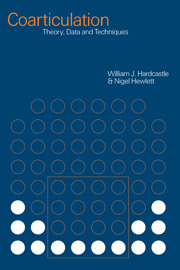Book contents
- Frontmatter
- Contents
- List of figures
- List of tables
- List of contributors
- Acknowledgments
- Introduction
- Part I Theories and models
- Part II Research results: components of the motor system for speech
- Part III Wider perspectives
- Part IV Instrumental techniques
- 10 Palatography
- 11 Imaging techniques
- 12 Electromagnetic articulography
- 13 Electromyography
- 14 Transducers for investigating velopharyngeal function
- 15 Techniques for investigating laryngeal articulation
- 16 Acoustic analysis
- References
- Index
12 - Electromagnetic articulography
Published online by Cambridge University Press: 22 September 2009
- Frontmatter
- Contents
- List of figures
- List of tables
- List of contributors
- Acknowledgments
- Introduction
- Part I Theories and models
- Part II Research results: components of the motor system for speech
- Part III Wider perspectives
- Part IV Instrumental techniques
- 10 Palatography
- 11 Imaging techniques
- 12 Electromagnetic articulography
- 13 Electromyography
- 14 Transducers for investigating velopharyngeal function
- 15 Techniques for investigating laryngeal articulation
- 16 Acoustic analysis
- References
- Index
Summary
Introduction
Electromagnetic articulography (EMMA) belongs to the category of transduction device that provides data on the trajectories of articulator fleshpoints in a two-dimensional Cartesian space. It thus provides data comparable to that available from the well-established X-ray microbeam system (cf. Westbury 1994). This contribution reviews some of the methodological issues involved in employing EMMA for phonetic investigations, particularly for studies of coarticulation. On the face of it, EMMA is extremely well suited to the study of coarticulation since it allows a wide range of utterances to be recorded in a single session (sessions of thirty minutes or more being feasible). Moreover, since it provides kinematic data in readily analysable form it should help to remedy one of the most serious failings of instrumental studies of coarticulation to date, namely the small number of subjects per experiment. EMMA is able to monitor the movements on the midsagittal plane of most of the articulatory structures that have been the focus of coarticulatory studies, i.e. lips, jaw, tongue and velum, but it is probably of most interest for the tongue, since for the lips and jaw other well-established techniques are readily available. Currently three main systems are available to individual laboratories: the MIT system (cf. Perkell et al. 1992), the AG100 system (Carstens Medizinelektronik, Göttingen, Germany) and the Movetrack system (Botronic, Hägersten, Sweden, cf. Branderud 1985).
- Type
- Chapter
- Information
- CoarticulationTheory, Data and Techniques, pp. 260 - 269Publisher: Cambridge University PressPrint publication year: 1999
- 13
- Cited by



